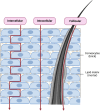Moisturising Gloves as a Solution for Occupational Skin Health: Advances and Challenges
- PMID: 40926555
- PMCID: PMC12586281
- DOI: 10.1111/cod.70025
Moisturising Gloves as a Solution for Occupational Skin Health: Advances and Challenges
Abstract
Extended glove usage is crucial in various occupational settings to safeguard workers and maintain hygiene standards. However, prolonged wear creates an occlusive environment that disrupts normal skin evaporation, leading to temporary overhydration. This reversal of the diffusion gradient facilitates the penetration of residual soaps and alcohol from hand hygiene practices, which can deplete skin moisture and cause irritation. Moisturising agents have been integrated into gloves to address occupational dry skin, as conventional lotions often suffer from low compliance and incompatibility with latex. Their selection requires careful optimisation to ensure effective skin penetration without compromising glove integrity or introducing manufacturing complexities. Additionally, variations in activation stimuli among individuals must be taken into account to ensure consistent efficacy. This review discusses advancements in moisturising glove technologies, including interlayer coatings, direct surface applications, matrix integration, microencapsulation and hydrogel-based controlled-release systems. Despite these innovations, research gaps remain in standardising hydration assessment methods, evaluating real-world performance and comparing the efficacy of moisturising gloves with conventional skincare methods. Addressing these challenges through further clinical studies is crucial for refining the design and effectiveness of moisturising gloves in occupational applications.
Keywords: dry skin; functional gloves; hydration; moisturising gloves; occupational skin health.
© 2025 The Author(s). Contact Dermatitis published by John Wiley & Sons Ltd.
Conflict of interest statement
The authors declare no conflicts of interest.
Figures



References
-
- U.S. Bureau of Labor Statistics , “Injuries, Illnesses, and Fatalities,” 2015.
-
- Kiely L. F., Moloney E., Sullivan G. O., Eustace J. A., Gallagher J., and Bourke J. F., “Irritant Contact Dermatitis in Healthcare Workers as a Result of the COVID‐19 Pandemic: A Cross‐Sectional Study,” Clinical and Experimental Dermatology 46 (2021): 142–144, 10.1111/ced.14397. - DOI - PMC - PubMed
-
- Diepgen T. L. and Coenraads P. J., “Occupational Contact Dermatitis,” in Kanerva's Occupational Dermatology, ed. Rustemeyer T., Elsner P., John S.‐M., and Maibach H. I. (Springer Berlin Heidelberg, 2012), 51–58, 10.1007/978-3-642-02035-3_8. - DOI
Publication types
MeSH terms
Substances
Grants and funding
LinkOut - more resources
Full Text Sources

